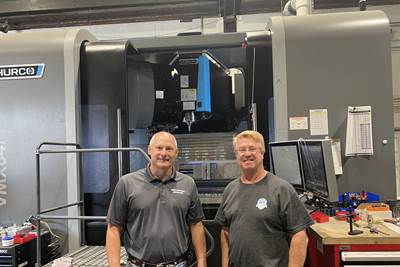In Wisconsin, November is hunting season. However, a record vacation buy-back indicates that from the fall of 2021 through end-of-year holidays, the outdoor enthusiasts at KLH Industries were pursuing a different form of game: new sales and production targets for precision-machined parts.
Kevin Heins, president, says forgoing vacation time is a choice that is never encouraged, even when better-than-expected performance creates opportunities to produce more than planned. Rather, he says the shop-wide commitment to take advantage of those opportunities was one example of an early payoff of a still-ongoing effort to “get everyone rowing in the same direction.”
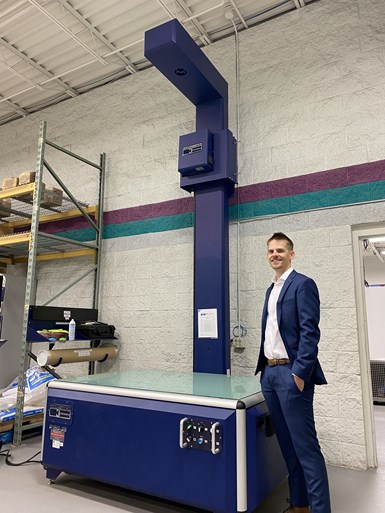
Kevin Heins, president of KLH Industries, shows off a new piece of equipment that fits the company’s “flywheel.” Conveniently located near the waterjets, this InspecVision Planar US visual inspection system uses a high-resolution camera to scan parts quickly and with minimal setup on a backlit glass surface.
This effort has not changed the company’s core drive: to serve customers better by adopting new technology early. Nor has it changed the fundamentals of the lean manufacturing process (which was celebrated in this publication in 2009), nor the nature of investments in the workforce. In fact, the company stands out enough in all areas of what makes a machine shop successful to earn a spot among this year’s crop of Top Shops, as identified by Modern Machine Shop’s annual benchmarking survey. However, a recent shop visit clarified what our read of the survey data had already suggested: The root of recent change at KLH is at the intersection of process, technology and people.
As the representative for the “Business Strategies and Performance” category in this year’s Top Shops Honors program, KLH Industries exemplifies what it looks like to codify a clear vision for success, then gain traction on that vision. In this case, the company is gaining traction on eliminating internal barriers to continuing along a growth trajectory that has propelled an 80% sales increase in the past five years. “The single biggest change was essentially saying: ‘This is what we’re going to do,’ then working backwards to achieve that goal, with accountability every step of the way,” Heins says.
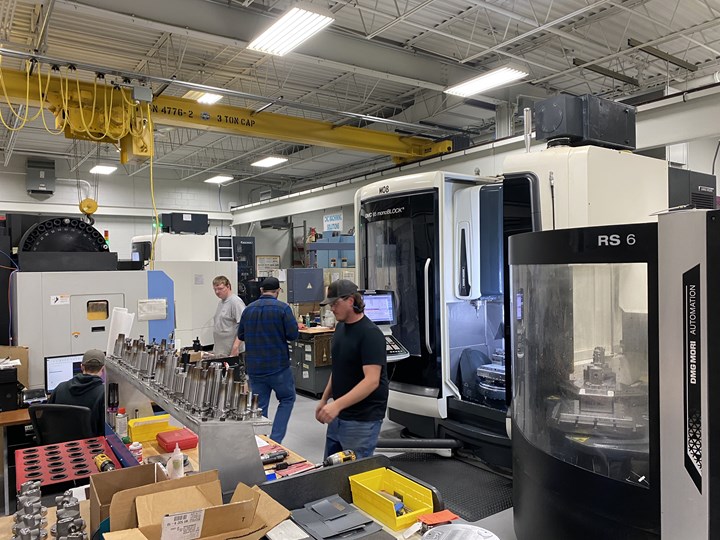
Although much of the recent change involves leadership, KLH Industries’ survey also reveals heavy investments in training, including involvement in apprenticeship programs and instruction for established employees.
Fly-Wheeling Off the Plateau
Input from Kelly Renz, a local consultant, is fundamental to the still-ongoing change at KLH Industries. However, Heins says KLH’s foundation was strong already. Much of the effort has been about defining and systematizing what has long made the business competitive.
This became apparent with one of the first exercises: defining the flywheel, a concept outlined in the book Good to Great by Jim Collins. The basic idea is that a business must identify the unique components of an income-generating “wheel” that defines the company’s purpose and gains more momentum as more effort is exerted to turn it. “This came together very quickly,” Heins recalls. “Our flywheel is basically striving to be early adopters of technology, which attracts a certain kind of work and a certain kind of people. Then turn around and reinvest back into top-performing equipment, and round-and-round it goes.”
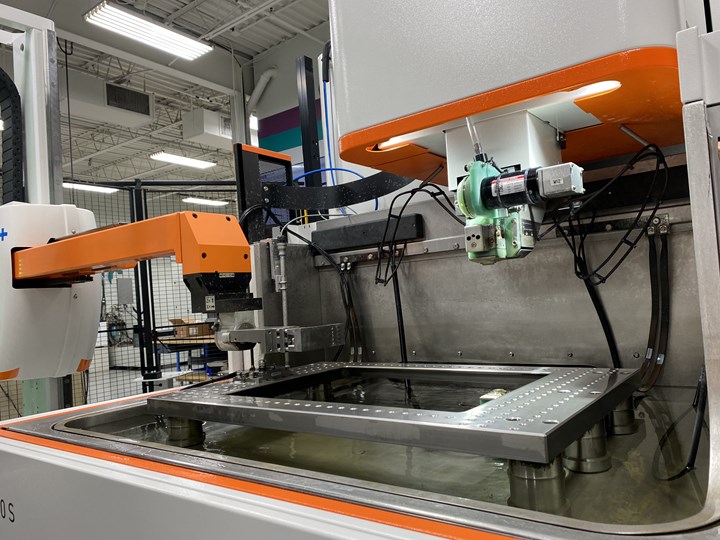
KLH Industries has invested in wire EDM continually since its founding with a single machine in 1987. The latest examples are robot-tended cells from GF Machining Solutions.
KLH’s flywheel first took shape in 1987, when Heins’s father, Kenneth L. Heins, founded the shop with a single EDM. A long-time tool and diemaker, the elder Heins intuited that EDM (a novel technology at the time) would have an outsized impact on his trade. Early growth was reportedly effortless and entirely word-of-mouth.
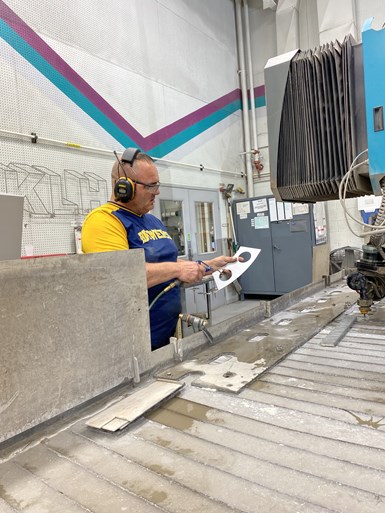
Waterjet technology set KLH Industries apart early by facilitating a more complete service for customers. Later, the addition of five-axis capability, water reclamation systems and other investments helped set the company apart even from other manufacturers with waterjet.
By the time the younger Heins joined the family business full-time in 2008, investments other machine tools rivaled those in EDM. Waterjets were busy cutting non-metal assembly components as well as machined-part blanks from titanium, Inconel and other aerospace materials. By 2011, the company had doubled in size for a fifth time to the current 35,000 square feet. The years since have seen the addition of the first five-axis waterjet, the first multi-axis machine tools and the automation of EDM and more. Veterans have risen through the ranks to lead each department, but the focus is increasingly on teaching others to “own” each specialty as well.
Nonetheless, the 45-employee company had reached a plateau of sorts by 2019, when father and son — who, along with Connie Heins, constituted the company leadership at the time — were introduced to a business methodology called the Entrepreneurial Operating System (EOS) at a seminar. Sales had been growing, but barriers to scaling were becoming apparent as well. As simple as it seemed, defining what constitutes KLH Industries’ flywheel also helped define what would impede its momentum.

Featuring a dedicated milling spindle rather than a tool turret, the DMG MORI NTX 2000 can not only minimize setups, but even stand in for a five-axis machine for parts cut from rounded stock. Two similar models from the company’s CTX series are pending delivery, and the plan is to tend the machines with collaborative robots.
Codifying Vision Means Codifying Culture
The two newest machine tools — two CTX Beta 1250 mill-turns from DMG Mori with dedicated spindles as well as tool turrets — exemplify the kind of equipment that fits KLH Industries’ flywheel. Pending delivery at the time of the MMS visit, these machines are a follow-up to the NTX 2000 pictured at left. All three offer capability to handle parts that would otherwise be routed to five-axis machining centers (or worse, multiple machine tools), and the two new ones will be tended by collaborative robots. Plans are to invest in additional training for these machines as well.
Such investments are in keeping the spirit that built this company. However, the decision to free floorspace for the new mill-turns by jettisoning other equipment came less naturally, Heins says. In hindsight, the machines to be replaced are monuments to what is now recognized as a potentially dangerous crack in the flywheel: allowing work opportunities to dictate investment decisions. “When you don’t have a documented strategy of your own, customers will help you choose it,” Heins explains.
In this case, a recent hire drove the point home when he reported that selling time on these machines seemed more difficult compared to other equipment in the shop. They lacked multi-axis capability, as well as accessories like tool probes and coolant chillers. Now, any expansions of the technological resume must fit the flywheel. They also must be accompanied by a focus on building redundancies by standardizing on machine capabilities and features.

The worktable of a DMG MORI DMU 75 five-axis machining center flips to reveal a laser tool probe. Standardizing on this and other features across machines eases scheduling by ensuring capacity is available where necessary.
Codifying the flywheel helped get the right technology in place, but getting the right people in place required a far more difficult task: codifying the company culture. Heins recalls spending hours listing the best attributes of people whom “we could take over the world with if there were 100 of them,” and then distilling those traits and characteristics into five core values. “We looked at these people who had been here so long and asked, ‘What made them so successful?’”
Now codified in writing, the core values are unique to KLH. As opposed to generic maxims about being honest or respectful (which Heins says are more like “expectations”), these values define how the right person for KLH might approach any endeavor, from hiring and performance reviews to process improvements to technology investments.
KLH Core Values:
Think Like a Customer
Challenge the Status Quo
Lift While You Climb
Big Things are Composed of Small Things
Attitude is a Choice
Consider “Challenge the Status Quo.” Inherent to this core value are ideas about measuring progress and outcomes, such as justifying the purchase of the mill-turns by seeking data to back up a hunch about just how many rounded workpieces were being directed to five-axis machines. More broadly, this core value is all about continuous improvement, which, until recently, had been impeded by the extent to which the right kinds of people are too busy (as the saying goes) working in the business to work on the business. This is why Heins didn’t ascend to KLH Industries’ leadership alone when he became company president in 2021.
The Flywheel Gains Traction
Paul Fredelake, director of finance, is one of the first additions to KLH’s new leadership team. He recalls being particularly confident early in the hiring process that KLH Industries would be a good fit early, and not just because the company had codified its flywheel and the right kind of person to turn it. The company had also codified specifically how he would be expected to help. In his case, 1- and 3-year targets included items such as decreasing the month-end closing process. Other roles are tasked with everything from to achieving cybersecurity certification to obtaining a federal license to manufacture firearms.
Having a vision, having a means to create a culture around uniquely defined core values and holding people accountable – these are all components that a lot of manufacturers and anyone in the skilled trades tends to struggle with.” – Kevin Heins, president, KLH Industries.
Most of the leadership’s attention is devoted to “rocks:” quarterly goals that must receive attention before the “pebbles.” As Fredelake explains it, differentiating the rocks from the pebbles requires “determining direction, clarity and alignment.” This encompasses not only the flywheel and core values, but also ongoing activities, such as quarterly, off-site meetings with Retnz as well as weekly on-site progress tracking meetings. Various tools on web platform ninety.io help ensure help ensure that goals are specific, measurable and achievable and that everyone understands what resources are required, from labor and materials to outside vendors or financing.
Assigning each “rock” to a single person, generally the leadership team member who is responsible for the relevant business function, helps vision gain traction through accountability, Fredelake says. That includes accountability for funneling the right work to the right people, because flywheel momentum depends on the cumulative, incremental efforts from all corners of the business.
Means of driving engagement include quarterly “state of the company” addresses as well as quarterly reviews with employees, in which feedback goes both ways, Fredelake says. Whether by tracking company-wide information or metrics related to specific job functions, “scorecards” provide visual indicators of progress toward goals. They help ensure “everyone in the organization is clear on whether we’re winning or losing the week of the day,” Fredelake says.
Last winter’s vacation buyback exemplifies what it looks like when all of these elements come together to push the flywheel. Another indicator that the strategy effort is gaining momentum is the extent to which meetings have changed, Heins adds. New tools and new tactics, such as scorecards and a focus on “tropical island” metrics — which he describes as “the 3-5 things you’d want to know to determine if things are going well while you’re on vacation” — now streamline the proceedings. “We used to spend a lot of time reviewing data instead of talking about root issues,” he says.
At the time of this writing, much of the work has yet to be done. Nonetheless, Heins says results so have been very much in-line with what he initially expected. As he recalls telling his father after the seminar where they met Renz, “This is what we needed. All the components she was talking about — having a vision, having a means to create a culture around uniquely defined core values and holding people accountable — these are all components that a lot of manufacturers and anyone in the skilled trades tends to struggle with.”
Related Content
Automated CAM Programming – Is Your Software Really Delivering?
A look at the latest automation tools in Autodesk Fusion 360 software and how forward-thinking machine shops and manufacturing departments are using them to slash delivery times and win more business.
Read MoreSame Headcount, Double the Sales: Successful Job Shop Automation
Doubling sales requires more than just robots. Pro Products’ staff works in tandem with robots, performing inspection and other value-added activities.
Read MoreFinding Skilled Labor Through Partnerships and Benefits
To combat the skilled labor shortage, this Top Shops honoree turned to partnerships and unique benefits to attract talented workers.
Read MoreTop Shops 2024 Is Now Live
The Top Shops 2024 survey for the metalworking market is now live, alongside a new homepage collecting the stories of past Honorees.
Read MoreRead Next
Machine Shop Scale-Up Mirrors Past Success
An aerospace manufacturer doubles down on a subset of work and a knack for turning shopfloor problem solving into marketable new products.
Read MoreHow a Mom-and-Pop Becomes a Top Shop
Process and culture shift as leaders adopt new business strategies and a singular focus on expanding and filling capacity.
Read More3 Mistakes That Cause CNC Programs to Fail
Despite enhancements to manufacturing technology, there are still issues today that can cause programs to fail. These failures can cause lost time, scrapped parts, damaged machines and even injured operators.
Read More


















.png;maxWidth=300;quality=90)









